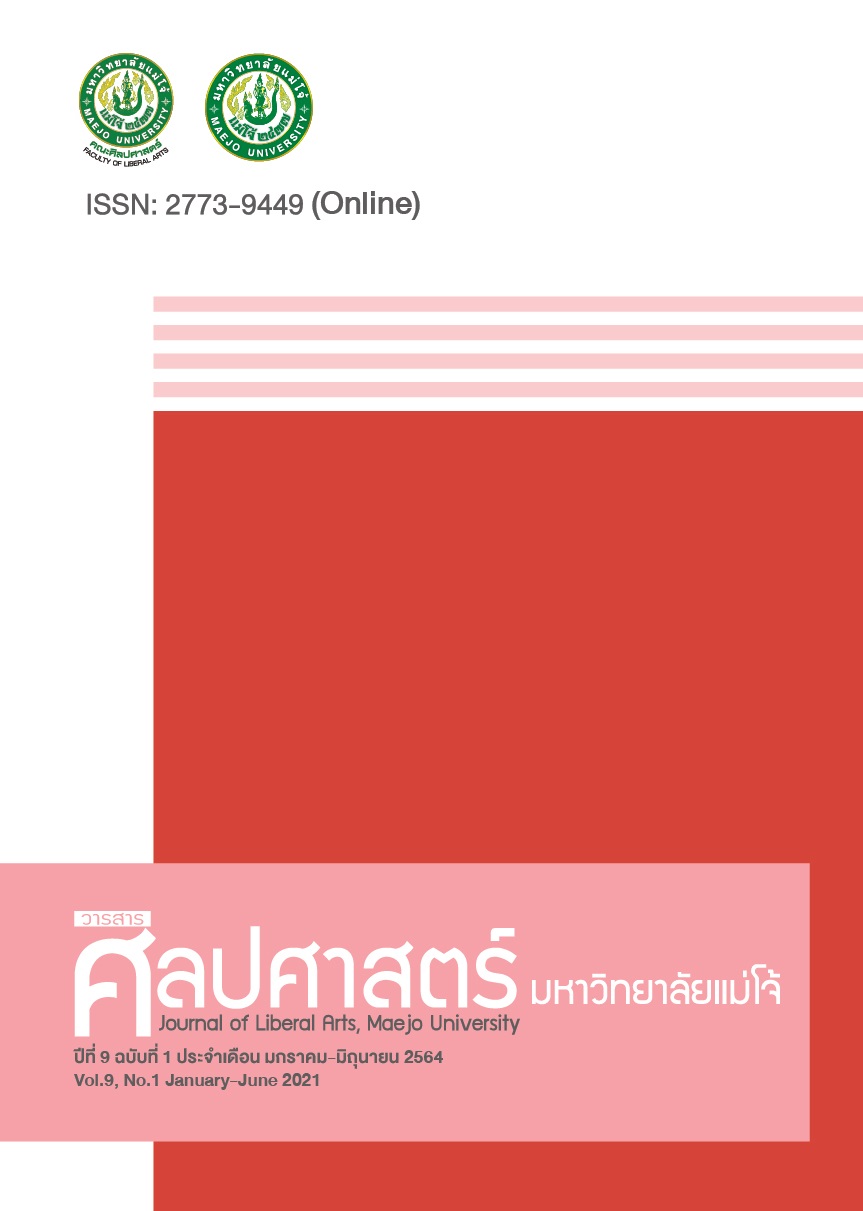Unveiling Online English Learning During the Covid-19 Era: An Analysis of Maejo University Students’ Perceptions and Achievement in Fundamental English 2 Online Learning
Main Article Content
Abstract
With the outbreak of Covid-19, online learning has become an important tool for education at all levels, including higher education. This research; therefore, aims to study Maejo University students’ perceptions towards English language online learning, and to investigate if there is a significant difference in students’ achievement between online and traditional classroom learning. The sample group was 856 students who enrolled in the Fundamental English 2 course in the first semester of 2020. Questionnaires and achievement tests were used to collect the data. The results of the statistical analysis showed that students’ perceptions were mostly neutral about English language online learning. As for their learning achievement, a significant difference between the two ways of learning was found. Students’ language learning achievement was better when they studied in the traditional classroom than when they studied online.
Article Details
References
Al-Fahad, F.N. (2010). The Learners' Satisfaction toward Online E-Learning Implemented in the College of Applied Studies and Community Service, King Saud University, Saudi Arabia: Can E-Learning Replace the Conventional System of Education?. Turkish Online Journal of Distance Education, 11(2), 61-72. Retrieved November 5, 2020 from https://www.learntechlib.org/p/157237/.
Aliweh A. M. (2011). Exploring Egyptian EFL Students’ Learning Styles and Satisfaction with Web-Based Materials, CALICO Journal, 29(1), 81-99. Retrieved September 12, 2020, from https://doi.org/10.11139/cj.29.1.81-99
Anderson, T. (2011). Theory and Practice of Online Learning. Edmonton: AB: AU press.
Antti, O., Tye, R., Lingyi, M., Eeva, R. (2012). Habits make smartphone use more pervasive. Personal & Ubiquitous Computing,16(1), 105-114. Retrieved October 16,2020, from http://eds.a.ebscohost.com/eds/pdfviewer/pdfviewer?vid=0&sid=c22ac569-0e9a-4177-89fa-69ecafa9bb27%40sessionmgr4007
Asoodar, M., Vaezi, S., Izanloo, B. (2016). Framework to Improve E-Learner Satisfaction and Further Strengthen E-Learning Implementation. Computers in Human Behavior, 63, 704-716. Retrieved October 18, 2020 from https://doi.org/10.1016/j.chb.2016.05.060
Caliner, S. (2004). An Overview of online learning. Massachusetes: HRD Press, Inc.
Chen, P.H. (2014). The relationship of flow experience, need satisfaction, perceptual learning style preferences, and EFL self-efficacy to EFL online learner satisfaction. (Doctoral dissertation). Available from Dissertation full text. (UMI Number: 3684757)
Chen, P.H. & Adesope, O. (2016). The effects of need satisfaction on EFL online learner satisfaction. Distance Education. 37(1), 89–106. Retrieved November 7, 2020, from http://dx.doi.org/10.1080/01587919.2016.1155962
Dahala, H., Hassan, H., & Atan, H. (2012). Student Engagement in Online Learning: Learners Attitude Toward E-Mentoring. Procedia - Social and Behavioral Sciences. 67, 464-475. Retrieved October 16, 2020, from https://doi.org/10.1016/j.sbspro.2012.11.351
Gyamfi, George & Sukseemuang, Panida. (2018). EFL Learners’ Satisfaction with the Online Learning Program, Tell Me More. Turkish Online Journal of Distance Education, 19(1), 183-202. Retrieved October, 15, 2020, from https://doi.org/10.17718/tojde.382798.
Hsiu-Feng Shih et al. (2013). The Relationship Among Tertiary Level EFL Students’ Personality, Online Learning Motivation And Online Learning Satisfaction. Procedia - Social and Behavioral Sciences, 103, 1152 – 1160. Retrieved December 1,2020, from https://www.researchgate.net/publication/273554513_The_Relationship_among_Tertiary_Level_EFL_Students'_Personality_Online_Learning_Motivation_and_Online_Learning_Satisfaction
Isik, O. (2006). E-Learning Satisfaction Factors, (n.p.) Retrieved September 22, 2020, from https://www.researchgate.net/publication/255570696
Jung, I. & Gunawardena, N. C. (2014). Culture and online learning: Global Perspectives and research. Virginia:Stylus publishing, LLC.
Kearsley, G. (2005). Online learning: Personal Reflections on the Transformation of Education. Englewood Cliffs, NJ: Educational Technology Publication, Inc.
Kızıl, A. S. (2014). Blended instruction for EFL learners: Engagement, learning and course satisfaction, The JALT CALL Journal. 10(3), 227-240. Retrieved September 25, 2020, from https://www.researchgate.net/publication/269927692_Blended_instruction_for_EFL_learners_Engagement_learning_and_course_satisfaction
Kızıl, A. S. (2017). EFL Learners in the Digital Age: An Investigation into Personal and Educational, Digital Engagement RELC Journal. 48(3), 373-388 Retrieved October 25, 2020, from https://journals.sagepub.com/doi/10.1177/0033688216684285
Kopp, C.M. (2020). Perceived value. Retrieved December 10, 2020, from https://www.investopedia.com/terms/p/perceived-value.asp
Kurt, S. (2020). "Vygotsky’s Zone of Proximal Development and Scaffolding," Educational Technology. Retrieved July 11, 2020. from https://educationaltechnology.net/vygotskys-zone-of-proximal-development-and-scaffolding/
La Piana, N. M. (2014). Comparing students’ perceptions of online language to traditional learning. (Doctoral dissertation). Available from Dissertation full text.(UMI Number: 3628916)
Mcpherson, M. & Nunes, M.B. (2004). Developing innovation in online learning: an action research framework. New York: RoutledgeFalmer.
Means, B., Bakie, M.,& Murphy, R. (2014). Learning online what research tells us about weather, when and how. New York: Ruthledge Taylor and Francis group.
Otter, R., Seipel,S., Graeff, T., Boraiko,C., Gray, J., Petersen, K. & Sadle K. (2013). Comparing student and faculty perceptions of online and traditional courses, Internet and Higher Education. 19, 27–35 Retrieved 21 october ,2020 from https://www.academia.edu/27598502/Comparing_student_and_faculty_perceptions_of_online_and_traditional_courses
Prensky, M. (2001). Digital natives, digital immigrants. On the Horizon 9, 9(5), 1–6. Retrieved November 9, 2020, from https://doi.org/10.1108/10748120110424816
Rudestam, K.E. and Schoenholtz-Read, J. (2010). A handbook of Online Learning. United States of America: Sage publication, Inc.
Shen, D. et al. (2013). Unpacking online learning experiences: Online learning self-efficacy and learning satisfaction, Internet and Higher Education, 19, 10-17. Retrieved November 9, 2020, from https://doi.org/10.1016/j.iheduc.2013.04.001
Sun, P.C. et al. (2008). What drives a successful e-Learning? An empirical investigation of the critical factors influencing learner satisfaction. Computers & Education 50(4), Retrieved November 9, 2020, from https://doi.org/10.1016/j.compedu.2006.11.007
Tafazoli, D. et al. (2018). A cross -cultural study on the attitudes of English language students towards computer-assisted language learning. Teaching English with Technology, 18(2), 34-68. Retrieved November 27,2020, from http://www.tewtjournal.org
Yordchim, S. & Gibbs, T. J. (2014). Satisfaction on English Language Learning with Online System. World Academy of Science, Engineering and Technology International Journal of Educational and Pedagogical Sciences, 8(8), 2530-2533. Retrieved December 19, 2020, from https://www.semanticscholar.org/paper/Satisfaction-on-English-Language-Learning-with-Yordchim-Gibbs/8987ecdc6ccec27dd65217753ddfb00334690d0d#citing-papers

